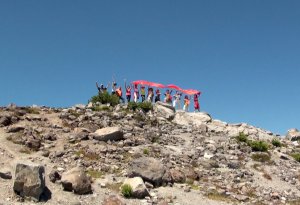如果 ESEIEH 技术实验成功并推广应用,SAGD 将可能成为历史,油砂企业对PE证书的需求会大为减少。
http://www.fortmcmurraytoday.com/
Suncor hopes tests will replace steam with radio waves
By
Vincent McDermott
Tuesday, July 21, 2015 6:02:26 MDT PM
Suncor Energy has begun a pilot project with several other partners that would liquify underground bitumen deposits like a microwave oven. The company has begun using radio frequencies, as opposed to steam, to produce heavy crude from underground oilsands deposits at Suncor’s Dover site.
The Enhanced Solvent Extraction Incorporating Electromagnetic Heating process (or ESEIEH, pronounced "easy"), blasts targeted radio frequencies at bitumen deposits deep underground. The deposits are heated until they are liquified, then mixed with a chemical solvent and siphoned to the surface through a horizontally-drilled well.
If the experiments succeed, Suncor believes ESEIEH could become a cheap and cleaner alternative to traditional mining practices.
“If proven successful, ESEIEH is expected to result in a reduction of up to 75% in energy requirements,” said spokesperson Erin Rees in an email interview. “ESEIEH doesn’t use any steam in the in situ recovery process, so it eliminates the cost requirements for water sourcing and handling.”
Aesthetically, Rees says eliminating water and steam treatment infrastructure has the potential to build even smaller plants.
In situ technology and steam-assisted gravity drainage plants are typically heralded as cleaner alternatives to open-pit mining in the oilsands, pumping the bitumen directly out from the ground once it’s loosened with hot steam.
The surface remains largely unscarred from the heavy haulers and digging equipment dotting surface mines.
But the technology is typically not as clean as industry partners would like. Burning fuel to transform fresh water into steam can produce more greenhouse gases per barrel of oil than traditional mining.
Construction and maintenance also involves clear cutting, with the Pembina Institute warning in 2006 that, “by even the most conservative estimate, there will be more long-term deforestation from SAGD development than if the entire mineable oilsands region is completely cleared.”
In situ may not be as much of an eyesore, but with most leases in northeastern Alberta holding bitumen deposits too deep for conventional mining, industry is researching alternatives to the alternative.
The consortium is made up of Devon Energy Corp., Nexen Energy and the Florida-based Harris Corp. The experiments began on a smaller scale in 2009 at Suncor’s North Steepbank Mine.
The tests were deemed a success in 2011, and this second phase, which costs $44 million, was announced in 2012. This current phase will continue for another two years. If this phase is also a success, it will lead to a commercial scale field test.
“It is important to note that establishing a baseline for the comparative costs versus traditional methods is a primary objective of this phase of the pilot,” says Rees. “It’s still early days in testing the technology.”
vincent.mcdermott@sunmedia.ca 然而,大火引发的浓烟覆盖了萨省的大部分地区,甚至飘到了美国,加拿大环境部已经向萨省和曼省部分地区,发布了特别空气质量警告。
然而,大火引发的浓烟覆盖了萨省的大部分地区,甚至飘到了美国,加拿大环境部已经向萨省和曼省部分地区,发布了特别空气质量警告。








 (7月18日、19日,周六周日两天,地点在素里荷兰公园,天车终点站)
(7月18日、19日,周六周日两天,地点在素里荷兰公园,天车终点站)




